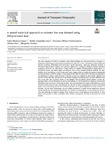A spatial statistical approach to estimate bus stop demand using GIS-processed data

Use this link to cite
http://hdl.handle.net/2183/40239
Except where otherwise noted, this item's license is described as Atribución-NoComercial-SinDerivadas
Collections
- Investigación (ETSECCP) [826]
Metadata
Show full item recordTitle
A spatial statistical approach to estimate bus stop demand using GIS-processed dataAuthor(s)
Date
2024Citation
Yaiza Montero-Lamas, Rubén Fernández-Casal, Francisco-Alberto Varela-García, Alfonso Orro, Margarita Novales. (2024). A spatial statistical approach to estimate bus stop demand using GIS-processed data, Journal of Transport Geography, 118, 103906, https://doi.org/10.1016/j.jtrangeo.2024.103906
Abstract
[Abstract:] This study integrates the fields of geography, urban transit planning, and statistical learning to develop a sophisticated methodology for predicting bus demand at the stop level. It uses a Generalized Additive Model that captures non-linear relationships and incorporates spatial dependence, improving traditional methods. It showcases a high predictive capacity with a pseudo R-squared of 0.79 during its validation, ensuring substantial explanatory power for new observations. A large number of variables, including land-use characteristics, socioeconomic factors, and transit supply, are analysed. These widely available predictors facilitate the transferability of the methodology to other urban areas. Transit supply predictor considers the number of annual trips per stop and area as well as the location of stops along the lines that serve them. GIS processing of the data allows the calculation of variables within the areas of influence of each stop, obtained by following the walkable street network. For the case study, the presence of universities, hospitals, and lodgings areas, as well as inhabitants and ratio of bus trips show a positive impact on bus demand. This geo-analysis process employs accurate disaggregated data, such as information on uses in each building, as well as methods for assigning socioeconomic information from local areas to residential buildings. This study highlights the complex relationship between the location of transit network stops, both along the bus line and in terms of geographical proximity, their transit supply, and its surrounding factors. The results indicate that there is spatial dependence for stops less than 1.15 km apart. The developed methodology provides reliable information to transit network planners for decision making. Specifically, this proposed methodology can contribute to designing new routes, optimizing stop locations, and estimating the impact of changes in the transit network or urban planning on bus demand. All these improvement measures promote sustainable urban mobility, consequently fostering environmental and social benefits.
Keywords
Geospatial analysis
Spatial dependence
GIS
Generalized additive models
Bus stop demand estimation
Transit planning
Spatial dependence
GIS
Generalized additive models
Bus stop demand estimation
Transit planning
Description
Financiado para publicación en acceso aberto: Universidade da Coruña/CISUG
Editor version
Rights
Atribución-NoComercial-SinDerivadas






